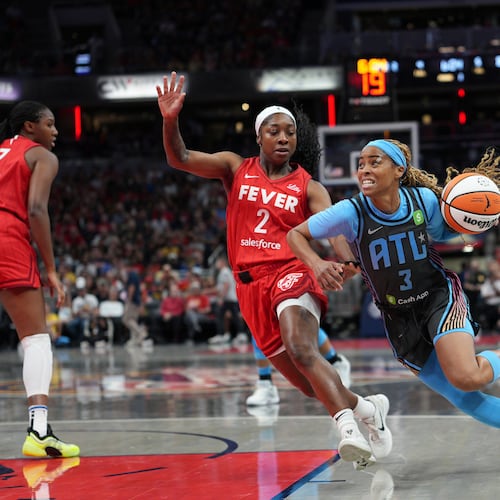ATHENS – Sometimes, Dustin Ware will turn on his TV, find a Lakers game and just sit and watch.
He’ll stare at the screen and nod as the defending NBA champs run their offense, and he’ll study the players’ movements as they read the defense and react appropriately, putting themselves in position for an easy basket.
As a young basketball player who is relatively new to the triangle offense and first-year Georgia coach Mark Fox’s version of it, there’s nothing like learning from the best.
“I’ll catch Kobe [Bryant] and Derek Fisher doing something that me and [Georgia teammate] Travis [Leslie] are doing,” said Ware, a sophomore guard. “We’ll catch certain things and see that’s just another variation they run. There’ll be a lot of little things we’ll pick up and stuff like that.”
Ware and the rest of the Bulldogs are gradually learning the triangle, an offense created more than 60 years ago that remains in vogue thanks to a longtime NBA assistant named Tex Winter who taught it to the Chicago Bulls in the early 1990s and the Lakers later that decade.
Those teams have won 10 of the past 19 NBA titles, dominating the league as Michael Jordan and Bryant and their supporting players flourished in the triangle.
“Kobe and Jordan cover a lot of sins, but it’s an equal-opportunity offense,” said Mark Slonaker, who ran the triangle for nine of his 11 seasons as coach at Mercer and is now the analyst on Georgia’s radio broadcasts. “When the kids come down the floor and make the right reads and right decisions and execute, any one of them at any time can score. It does lead you to a balanced attack, and it makes it tough for the other team to scout you.”
Fox grew interested in the offense as an assistant at Washington from 1991 to 1993 and immersed himself in it when he took an assistant coaching job at Kansas State in 1994. Winter had coached at both schools in previous decades and still owned a home in Manhattan, Kan., so Fox began meeting with Winter and learning from the man who literally wrote the book on the offense.
Winter’s “The Triple-Post Offense” was originally published in 1962 and is a must-have for any coach interested in the offense. Both Fox and Slonaker have well-worn copies.
“[Winter] was with the Bulls at the time, but he was always real generous with his time and I got to know him through his trips back to Manhattan,” Fox said. “I’d study the offense and got to learn it from its inventor.
“When I was at Nevada, he’d make trips to Reno and I’d be nervous sitting there watching tape with him. I’d hit the play button and show him how we changed something as opposed to how he did it. And he was always supportive of the wrinkles we’d implemented. He was generous to me. I’m forever grateful to him.”
Winter, who is 87, suffered a stroke on April 25 and has struggled to regain his speech. He was at the Lakers’ opener on Oct. 27, but otherwise he lives in an assisted-living facility in Oregon.
With Winter’s encouragement, Fox began to tinker with the triangle at Nevada, where he was the coach from 2004 to last spring, when he was hired to replace Dennis Felton at Georgia. Fox’s teams dominated the Western Athletic Conference, winning three titles, tying for another one and making three NCAA tournament appearances in five seasons, thanks in part to the triangle.
He brought the offense with him to Georgia, where he began teaching it to a team with only three seniors. Fox, Slonaker and ESPN analyst Fran Fraschilla, a former coach at Manhattan, St. John’s and New Mexico, all agree that it will take time for the Bulldogs to fully grasp the offense, which is based on reads and reacting and trusting teammates to make the same reads. It also requires players to make instant decisions and be precise in their spacing.
“It’s not natural, so there’s a learning curve,” Georgia sophomore forward Trey Thompkins said. “There’s a lot of trust involved, and we have to know how to read the defense and know where to go. There’s a learning curve because of all the different options off of it. It’s going to take time to master.”
The triangle takes its name from how players set up as the offense is initiated.
A guard will pass the ball to a wing on either side of the court, and those two players, along with a player in the low post, will form a triangle based on where they’re standing.
The wing will then decide how to distribute the ball, according to strengths and weaknesses of the defense, but Slonaker said he liked his first option to be the post.
“That first pass will trigger all the action," he said.
If the post player is covered or doubled, the wing will pass the ball depending on who is open. Those options usually include a guard in the corner, the trail guard and a forward/wing who might be flashing into the lane.
If a team runs the offense and exhausts the options, it can reset the triangle and try again.
“The triangle is structured motion,” Fraschilla said. “Instead of freelancing or a motion offense, the coach has more control of where his players move on the court, but it still allows the freedom to read and react to how the defense plays you. It relies more on the trust of players to know how to read the defense and knowing where to go.”
Ware said: "It’s not exactly freelance. It lets guys play ball, but within a set of rules."
And while wing players such as Jordan and Bryant are triangle anomalies, the right triangle promotes a balanced attack. Slonaker said he had wings, post players and guards lead his teams in scoring.
That’s held true at Georgia this season. Thompkins (post), Leslie (wing), Ware (guard) and Ricky McPhee (guard) each led the Bulldogs in scoring in their first four games. Only Thompkins has led the team in scoring more than twice this season.
“It provides a lot of different places to score,” Fox said. “We’re finding scoring opportunities, but we’re not as proficient as we’d like to be. We don’t have the firepower that ideally we want to possess.”
Fox continues to ease his players into his triangle hybrid. He will use a mixture of set plays and the triangle as the Bulldogs become more comfortable with the offense.
The players are confident their proficiency will rise as the season progresses, and Ware thinks they’ll have a firm grasp of it by late January or early February.
“As we become more accustomed to it, we’re starting to find more seams and cracks in the defense where we can find easy buckets, instead of running all of our offense,” Thompkins said. “We’re getting better at it. I think we’re going to be able to become a great team with this offense.”
About the Author
Keep Reading
The Latest
Featured

